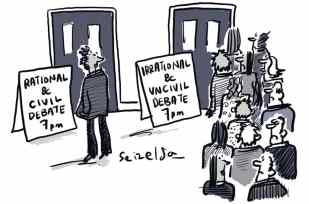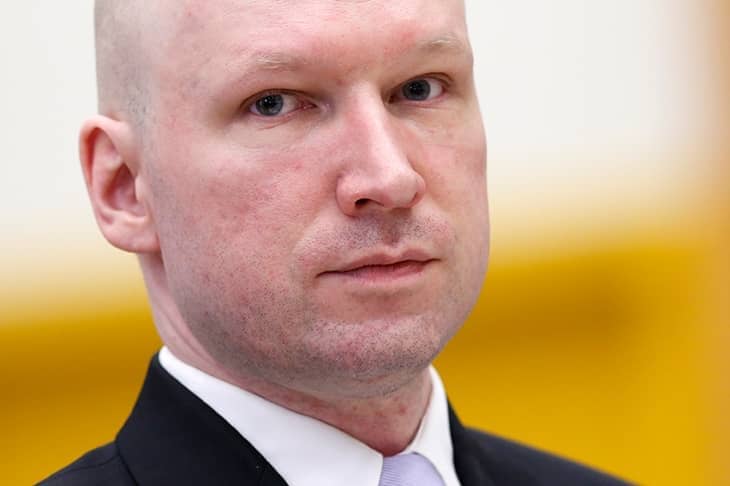On the wooden jetty from which the ferry used to depart for the little island of Utoya, there stood for a while a small obelisk around which people deposited flowers. ‘If one man can show this much hate, imagine how much love we can show together’ was the marvellously trite inscription on the obelisk: vapid and close to meaningless, in either Norwegian or English. Utoya lies in the Tyrifjorden Lake about 45 minutes north of Oslo and it is where the Labour party’s ‘Workers’ Youth League’ once held its summer camps — until one afternoon in July 2011 when a man called Anders Breivik turned up, heavily armed.
Breivik murdered 69 people on Utoya, 33 of them under the age of 18. Hours previously he had killed eight people through a car bomb detonated beneath a government building in the capital. The consensus among Norway’s understandably shocked public and polity was that Breivik was insane, and this was indeed the first finding from a team of psychiatrists. But as time progressed this view was challenged for reasons which can only be described as political. The left argued, with some force, that Breivik was not mad, he was simply very right-wing. His murderous actions were the direct consequence of his own repulsive politics: that, said the left, is where a dislike of immigration leads you. The politics of hate — hence that dim-witted inscription on the obelisk. Breivik was re-examined and pronounced to be sane. He is now banged up for 21 years.

I thought of Breivik when I read about the latest outrage in Norway — the ‘bow and arrow’ killer, Espen Andersen Braathen, 37, who murdered five people at random in the town of Kongsberg, having shot them with his arrows and finished them off by stabbing them, it seems. Three more were injured. The immediate response to this appalling deed was very different to that which greeted Breivik’s carnage. It was revealed very quickly that Braathen, a Danish citizen, was a convert to Islam and the authorities immediately announced that they were treating the incident as a terrorist attack. That was little more than a week or so ago.
Now, however, the authorities have changed their minds. The latest statements from the Norwegian police suggest that they are playing down Braathen’s religious affiliations and are instead concentrating on the fact that he had mental health issues. In other words, the Norwegian establishment is doing precisely the reverse of what it did in the case of Anders Breivik.
Is Braathen mad? Well, he attacked random people with a bow and arrow before stabbing them. That seems to me an act which one might reasonably describe as occasioned by lunacy. But by the same token we have become somewhat used to the authorities — over here even more so than in Norway — explaining away what seem, on the face of it, to be acts of Islamic extremism by telling us that in fact they are merely the consequence of insanity. With Breivik, then, his right-wing beliefs led directly to the murders of 77 people. Braathen’s radical Islamic beliefs, however, were of vanishingly little significance in helping us to understand the murders he committed.
All of these murders are committed by deeply disturbed individuals and sociopaths
You will remember too that the grotesque murder of Labour MP Jo Cox by Thomas Mair in 2016 was immediately identified as an act of far-right terrorism, which led to our intelligence services increasing their monitoring of supposed right-wing extremists. Nobody suggested Mair was simply mad. In the Times, David Aaronovitch, in an unusually stupid piece of writing, even linked Cox’s murder to the language of pro-Brexit campaigners.
I have a problem with this patent inconsistency. The yearning on the part of the left to find what we might describe as ‘evil’ in right-of-centre opinions leads directly to the corrosive political divide we have now, where the deputy leader of the Labour party can describe Conservatives as ‘scum’ and be cheered to the rafters. At the same time the left will exculpate Islam because to do other-wise would be counter to its agenda.
My own analysis is perhaps simplistic. All of these murders, by the far right via Islamist jihadis to the Red Brigade and the Baader-Meinhof Gang, are committed by deeply disturbed individuals and sociopaths who should be in the booby hatch. I tend to cleave to the view expressed by one of the first psychiatrists who examined Breivik and later saw his reputation thoroughly trashed when the political tide turned the other way. Torgeir Husby told me, back in 2015: ‘My theory is that violence is the primary thought and that the political ideology comes along afterwards. His political world exists just to have a world to be psychotic in.’ That diagnosis at least has the benefit of a certain clarity. Ideology should not itself bear responsibility for acts of carnage and violence: the individual is to blame, not the world view to which he or she subscribes. But then that leaves us with a difficulty regarding the National Socialists in Germany and the more recent manifestation of unrestrained sociopathic violence by Isis.
There is one more twist to this conundrum. Another reason for the Norwegian authorities performing an abrupt volte-face on Breivik was the stunning leniency of Norway’s laws governing the incarceration of the mentally ill. As Breivik’s sanity was being reassessed, a chap dubbed ‘The Halloween Killer’ — real name kept secret to preserve his privacy, natch — was released on licence from a mental institution only months after he had murdered his best friend, wounded another and daubed religious slogans. He had, according to the doctors, ‘got better’. That is the law in Norway. What if Breivik suddenly got better, too? The way in which we react to these crimes is always contingent, then, and guided by our political beliefs — something we should remember as we grieve for poor David Amess.







Comments